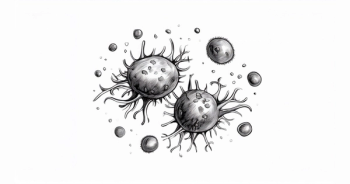
Peers & Perspectives in Oncology
- September II 2025
Durable Responses Are Achievable for Steroid-Refractory Chronic GVHD
During a live event, Nelson J. Chao, MD, discussed key outcomes from the trials supporting the use of ruxolitinib and axatilimab in patients with chronic graft-vs-host disease.
Chronic graft-vs-host disease (GVHD) affecting multiple organs after allogeneic stem cell transplant is a difficult condition to treat, particularly in patients whose GVHD is refractory to steroids. In a recent
Targeted OncologyTM: What data support the use of ruxolitinib in patients with chronic GVHD?
Nelson Chao, MD, MBA: This is the phase 3 REACH3 trial [NCT03112603]. This was a remarkable trial in chronic GVHD, primarily for the number of patients: 324 patients is a significant number of patients enrolled.1 This was a randomized trial of ruxolitinib. The critique of this study was that the control arm was the best alternative therapy [BAT], which is not unreasonable, but it didn't have a standard comparator. The BAT could have could be extracorporeal photopheresis, low-dose methotrexate, mycophenolate mofetil, mTOR inhibitor, infliximab [Remicade], rituximab [Rituxan], pentastatin, imatinib, and ibrutinib [Imbruvica]. There was not a standard comparative group, but it was what these different centers had as their go-to modality.
The eligibility was standard. These are patients who had severe chronic GVHD based on the National Institutes of Health [NIH] consensus criteria, and the primary end point was overall response rate [ORR] at 6 months, and the secondary end point was failure-free survival [FFS] and the [modified] Lee symptom score.
The characteristics were very well balanced with 165 patients on ruxolitinib and 164 in the control arm. The median age was balanced. There was not much difference between [the arms in terms of] the severity or what type of therapy the patients got in the past.
What were the updated outcomes of this trial after crossover?
There's a significant difference in FFS in the patients were allowed to cross over, which makes OS [overall survival] problematic, but clearly FFS is very different between ruxolitinib, which was a median of 38.4 months compared with the BAT at 5.7 months. It's a significantly different HR [of 0.361; 95% CI, 0.268-0.485].2
The duration of response was significant. It was not reached with ruxolitinib compared with the BAT, which was 6.4 months. Because it was a crossover, there was no difference in OS.
If you look at response in the primary and crossover, this is quite interesting, because if you look at the primary analysis, the ORR for ruxolitinib was [49.7%], and if you look at the crossover—these are patients who failed BAT and then went on ruxolitinib—the responses are very similar. It's interesting in that the BAT didn't ultimately impact the patients who were going to respond to ruxolitinib.
At 24 weeks of the crossover period, the best ORR between the responders and nonresponders overall was pretty good. The best ORR was 57 patients [81.4%] with a reasonable percentage of these patients responding.
What was the safety of ruxolitinib in this trial?
The safety was not surprising. The ruxolitinib group had more grade 3 adverse events [AEs], primarily based on cytopenias, but it was not a dramatic difference between ruxolitinib and BAT, and in the crossover group, there was significantly less, presumably, as these patients had been treated with other drugs at the time.
If you look at AEs in more than 15% of patients, anemia is higher; this is a known AE of ruxolitinib. Neutropenia is higher as well with ruxolitinib. Pneumonia was not different, so infection was not a significant problem, even though there was more neutropenia.
What is the significance of the AGAVE-201 trial (NCT04710576) in chronic GVHD?
The AGAVE-201 trial was a phase 2 trial of axatilimab. The thing that's interesting about axatilimab is the mechanism of action which is focusing on the macrophage-monocyte axis and fibrosis. This also included pediatric patients. It randomly assigned patients to 3 different doses at 0.3 mg/kg [every 2 weeks], 1.0 mg/kg [every 2 weeks], and 3 mg/kg [every 4 weeks] and the primary end point was ORR after the first 6 cycles based on the NIH criteria.3
What were the outcomes overall and based on organ-specific response?
What was interesting is the dose response curve wasn't exactly what you would expect. The higher dose did the worst. It's not clear why that is, but 0.3 mg/kg and 1.0 mg/kg did OK, probably not terribly different [74% and 67% ORR, respectively], but 3 mg did not do quite as well [50%].
If you look at the 0.3-mg dose group, the gastrointestinal [GI] tract had terrific responses with basically complete responses [CRs]. If you look at the lower GI, upper GI, and esophagus, it was quite a high number of CRs [89%, 82%, and 65%, respectively]. The fascia was not quite as good [20% CRs plus 56% partial responses (PRs)]. The mouth wasn't as good [42% CR and 10% PR]. The lung was OK, only the CR rate was low [16% CR, 31% PR]. Overall responses weren’t too bad, but the eyes and skin were not quite as good.
If you look at organ-specific responses, looking at the duration of treatment, it does take some time to get to the responses, in the lower GI, the upper GI, and so forth. If you look at each across the board, you can see that the longer they stayed on the therapy, the more likely they were going to get to response.4 This is not surprising, because the mechanism of action here is to reverse fibrosis, and sometimes fibrotic lesions are not going to reverse if it's tied down. It is a higher bar, if you will, than just looking at inflammation.
What were the safety outcomes with axatilimab?
It was reasonably safe; it's not without grade 3, if you look across the 3 different doses, there was clearly more toxicities with the higher dose, including 6 fatal AEs [along with with 7 fatal AEs in the 1.0 mg/kg group and 1 in the 0.3 mg/kg group]. The high dose was not much better and clearly was much more toxic.3
DISCLOSURES: There were no known relevant disclosures.






































